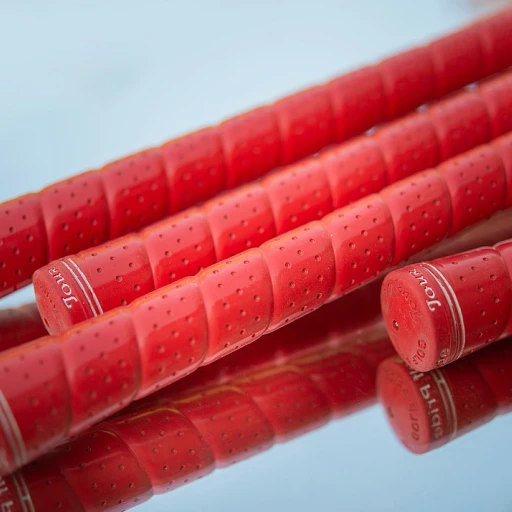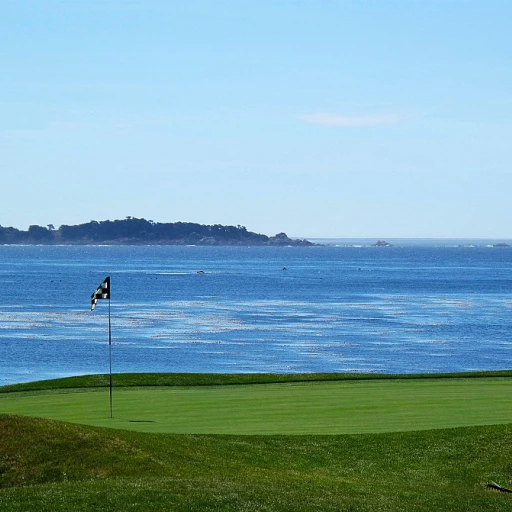
Understanding the Role of Sand in Golf Courses
Sand's Integral Role in Golf Courses
Golf is a game of finesse, and sand plays a crucial role in shaping its landscape. From the sprawling bunkers to the meticulously maintained greens, sand is pivotal in defining both the aesthetics and the playability of a golf course. Not all sands are created equal, and understanding their composition and function is key.
First, when it comes to sand bunkers and their maintenance, the type of sand used can dramatically impact the game. The texture, color, and particle size all influence how the ball interacts with the sand. Selecting the right bunker sand can mean the difference between a manageable play and a frustrating experience. Our article on how to elevate your short game through luxury chipping challenges offers a deeper dive into how these aspects affect play.
Moreover, beyond bunkers, sand contributes to the overall health and performance of turf on the course. Often used in topdressing mixtures, it aids drainage and promotes healthy grass growth. Infiltration rate becomes a concern as well – a course sand that allows for efficient water drainage ensures playable conditions even after heavy rain. It's a delicate balance to maintain, involving the right mix of road base and gravel components.
Apart from function, the color and appearance of sand add to a course's visual appeal. Whether opting for a white pristine look or the natural hues of brown or pea gravel, the chosen aesthetic should complement the surrounding environment. Various sand types, from crushed rock to more refined construction sand, create these visual landscapes that many golfers have come to associate with the world-class courses they cherish.
In summary, the selection and management of sand in golf courses integrate both art and science. With a deeper understanding of these elements, course managers can optimize their facilities to cater to a premium experience that players expect from luxury venues.
Characteristics of Premium Golf Course Sand
Characteristics of Elite Sand Solutions
When it comes to crafting an unforgettable golfing experience, the selection of sand for bunkers and course features plays a crucial role. An elite sand solution not only enhances the aesthetic appeal of the golf course but also contributes significantly to playability and maintenance efforts. The true secret lies in the sand’s particle size and shape. For golf courses, selecting the appropriate particle size is paramount. Top-grade bunker sands are typically comprised of angular particles. This structure aids in enhancing the "angle of repose," providing the needed resistance to ball penetration. Another determinant is the infiltration rate. A sand with the right rate ensures adequate drainage, preventing waterlogging after rainfall. This is critical in maintaining bunker conditions conducive to premium play. Beyond functionality, color adds to the allure. While the classic white sands always exude luxury and cleanliness, variations in shades like brown or even mix materials like sand glass can contribute a unique charm to the course's visual layout. Sourcing premium sands involves a fine balance of materials. A mix of topdressing sand and course sand, possibly infused with a hint of pea gravel, ensures not only playability but elegance. Moreover, the inclusion of construction materials such as stone, rock, or gravel might be considered for specific landscaping solutions. Some golfers might not realize the unseen characteristics of quality bunker sands. It's essential to understand that inferior sands tend to contain silt clay or sand peat, which negatively impact playability and aesthetic value. Hence, sand selection should be meticulous and conscientious. This intricate process is not just about appearances; it's about ensuring that players can fully immerse themselves in the game. Luxury sand wedges make perfect companions in maneuvering these precisely engineered terrains, offering the ultimate golfing experience that top establishments strive for.Sourcing and Sustainability of Golf Course Sand
Exploring Sources: From Quarry to Course
When it comes to sourcing materials for premium golf course sands, the journey begins far from the greens we admire. The origins of this essential component can be traced back to expansive quarries where natural resources such as stone and rock are meticulously selected and processed. These materials form the basis of the sand compositions that maintain the integrity and aesthetics of a premier golfing experience. Sustainability is a significant concern in the choice of sand. Many golf course managers are keen to select sustainable sand products that minimize environmental impacts while providing exceptional quality. For example, the incorporation of recycled glass and other eco-friendly materials as alternatives for topdressing sand ensures that the impact on natural resources is reduced. The quality of sand used can vary from pristine white bunker sand to tougher construction sand or road base for less visible areas. For high-quality sand bunkers, choosing sands with a consistent particle size and shape, like pea gravel or bunker sands with the right angle of repose, is critical for maintaining playability and aesthetics. An increasing trend in the industry is the local production of sand to decrease transportation costs and support local businesses. By sourcing bulk sand locally, environmental impacts like fuel emissions can be significantly reduced. Building upon these practices, innovative technologies in sand production, such as advanced sieving processes and surface treatments, contribute to the evolution of sand products. These enhancements not only improve the infiltration rate, contributing to a healthy turf above, but they ensure that the qualities of the sand—such as color, particle size, and resistance to compaction—match the precise needs of each golf course layout. For golf course operators and designers, investing in the right mix of sand, silt clay, rip rap, and sand peat, all attuned to local conditions, can spell the difference between a superb golf experience and a fairway full of frustrations. Understanding these subtleties is as crucial as mastering your swing for optimal performance on the course. For insights into optimizing your swing speed with equipment tailored to your physicality, read more here.Impact on Playability and Aesthetics
Enhancing the Course's Visual and Functional Appeal
The impact of sand on the visual and functional appeal of golf courses should not be underestimated. Meticulously chosen sand products, including white sand, brown stone, and glass-like particles, can transform the aesthetic allure of golf courses. Sand bunkers strategically placed across the course not only challenge golfers but also serve as a canvas for stunning visual artistry. The choice of sand can range from the typical course sand used in greenside bunkers to the bulk sands suitable for fairway bunkers and even decorative pea gravel or rip rap. However, the aesthetic impact isn't the only consideration. The angle of repose and particle size of the selected construction sand play vital roles in maintaining the sand's functionality, particularly its infiltration rate and stability in varying weather conditions. Moreover, brown topdressing sand and gravel mixes influence the turf's appearance and health. Appropriate particle shape and consistency ensure the perfect balance not just for aesthetics but for optimal playability, reducing the likelihood of fluctuating conditions that could impact the golfer's performance. By blending visual appeal with application-specific demands, the right sand selection underscores both the artistry and practicality inherent in golf course design. This intricate mix of materials sets the stage for exceptional golfing experiences, where aesthetics and playability come hand-in-hand.Maintenance Practices for Optimal Sand Conditions
Guidelines for Maintaining Pristine Sand Conditions
Maintaining optimal conditions for sand on a golf course is critical to ensuring that the course not only looks aesthetically pleasing but also provides a seamless experience for golfers. Proper maintenance of sand in bunkers and other areas consists of various practices that preserve its quality and performance. Firstly, regular raking of the sand is essential. This practice smooths out footprints and other disturbances, maintaining a consistent surface. Daily raking can help maintain the desired angle of repose, which affects playability. The choice of rake and technique can influence the sand's particle shape and distribution, impacting the overall appearance and performance. Next, it's important to address the drainage capabilities of sand bunkers. Poor drainage can lead to compacted sands that affect playability and the aesthetic of the course. Regular checks and maintenance of the infiltration rate ensure that the sand remains free-draining, preventing waterlogging and quickened deterioration. Moreover, topping up and replacing sands periodically helps maintain the surface texture and color. High traffic on the course may lead to the loss of sand, particularly in bunkers. Replenishing the sand using a consistent particle size mix helps maintain uniformity and functional properties. Different materials such as the inclusion of gravel or rock elements might be used under the sand as a road base to improve stability and prevent washing away during heavy rain. Additionally, the use of topdressing sand helps in maintaining smooth and receptive green surfaces. A mix of sand peat and silt clay can be utilized for effective topdressing. Consistent application of a mix topdressing ensures that the turf remains thick and healthy, contributing to the overall playability and aesthetic appeal. Finally, sustainable practices should not be overlooked. Sourcing materials responsibly and ensuring the longevity of the sand product can help minimize the environmental impact associated with maintaining golf course sands. Emphasizing the use of bulk materials like pea gravel or rip rap in designs can further ensure both functional efficiency and environmental consciousness. By implementing these strategies, golf courses can sustain premium sand conditions that enhance both the aesthetic and the playability of the course, providing a luxurious experience to all golfers who traverse these magnificent landscapes.Innovations in Golf Course Sand Technology
Revolutionary Advances in Golf Course Sand Technologies
The evolution of golf course sand is nothing short of remarkable, thanks to continuous innovations shaping the future of these luxurious retreats. As we've seen throughout this exploration, sand's role is integral, affecting everything from playability to aesthetics. Here, we delve into the cutting-edge technologies being developed and implemented.
Recent advances have focused on refining the particle size and shape of sand to create the ideal balance. Manufacturers use sophisticated machinery to control these features, ensuring each grain precisely meets standards that optimize the angle of repose and minimize washouts, thus maintaining bunker integrity.
Moreover, the advent of chemical treatments alters how sand interacts with water. By modifying sand's infiltration rate, these innovations facilitate faster drainage and reduce water retention. This development enhances the course's play conditions following adverse weather, maintaining the bunker's status as a strategical challenge rather than a hazard.
Environmental considerations play a significant role in driving innovation. Companies now prioritize sustainable sourcing practices by utilizing reclaimed materials in their mixture, such as finely crushed glass combined with natural sand. This not only broadens the color palette from traditional white to nuanced shades of brown but also helps reduce the ecological footprint of sourcing virgin sands.
Not just limited to bunkers, topdressing sand has seen changes, incorporating elements like sand peat in its formulation to improve turf health. Coupled with regular maintenance practices, discussed previously, these innovative products are transforming greens into pristine, resilient surfaces.
As construction methods advance, mixtures including pea gravel, rip rap, and even specific road base applications are influencing course design. These elements empower landscape architects to create sustainable, visually appealing features.
The world of premium golf course sand is continuously evolving with new technologies ensuring that every swing, shot, and putt reflects the ultimate luxury experience.













